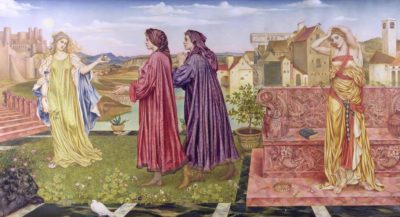This month, Louise Reasbeck who works at Cannon Hall, has taken a fresh approach to interpreting Evelyn’s paintings through the floral symbolism imbued in the paint.

Flower images adorn the paintings of Evelyn de Morgan, the associated symbolism adding to the fascination and layers of meaning of her work. No colour, character or detail is present in her work by anything other that careful design or creative or moral intent and this is true of the often incidental-seeming images of flowers in her paintings. Her depiction of exquisitely detailed, botanically accurate flowers and plants adds to the impact for the viewer and this is especially so when there is some understanding of the flowers’ meaning in the context of the picture.
Different sources attribute different meanings and significance to the flowers depicted in Evelyn de Morgan’s paintings but the association outlined below are those most readily used by artists and writers in the late 19th and early 20th century. By investigating the possible meanings of the specimens depicted in Evelyn’s work, we may gain a deeper insight into her motives for including these in her paintings and the messages she hopes to convey by their inclusion.
The use of flowers and plants to add subtle layers of meaning to a painting is particularly exemplified in Evelyn’s painting entitled the Garden of Opportunity which depicts two young men facing the choice between the paths to wisdom and folly. In addition to much symbolism in the background alluding to transience and permanence, frivolity and prosperity, there are numerous fastidiously detailed depictions of flower and plant specimens. The meanings of these flowers and plants seem to help to summarise the thoughts and feelings of the two young men pictured as they deliberate over their impending decision.
In the foreground:
- Pink roses are redolent of love, purity and unconscious adoration.
- White daisies and pink bellis flowers suggest innocence and purity.
- White crocuses are indicative of cheerfulness and gladness of youth.
- Pansies bring to mind loving thoughts.
Behind our two young men are clay pots containing other recognisable plant specimens.
- Lemon plants represent cleansing and healing.
- Aloe leaves suggest bitterness.
In the hand of the yellow-clad female tempting the youths towards folly is a sprig of henbane – a nod to her miraculous and hallucinatory powers.
In her portrayal of Love’s Passing, reminding us of the transience of love and life itself, Evelyn chose to augment the image of the young couple in the first flush of love with images of daisies symbolising innocence and purity and cyclamen flowers which themselves indicate deep love. These signs of love are overshadowed by the image of an elderly woman on her journey to the hereafter, reinforcing our thoughts that life is short for all of us and that happiness is tenuous. Perhaps this is another reason for the inclusion of daisies which can, in addition to suggesting innocence and purity, represent the bidding of farewell.





